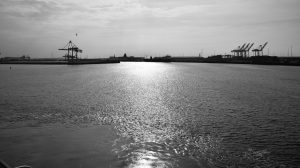Welcome to our blog series looking at the causes and consequences of well known disasters. This blog looks at The MV Herald of Free Enterprise Ferry Accident in 1987.
The Incident
The car ferry MV Herald of Free Enterprise was a catastrophic accident claiming many lives and injuring many both physically and psychologically and loss and damage to cargo. It seems unimaginable that the ferry set sail with the bow doors open.
On 6th March 1987 at around 6 pm, the Herald of Free Enterprise, a roll on/roll off passenger and freight ferry, left Zeebrugge for Dover. There was a crew of 80, and the ferry carried 131 vehicles and around 459 passengers. The weather was good with an easterly breeze and little sea swell.
At about 6.28 pm the ferry capsized, although it didn’t sink completely. Within five minutes, enough water filled the ferry below the surface level to kill 193 people.
The Causes
The contributing factor to the cost of 193 lives was the absence of a robust system for ensuring that the critical information on the closure of bow doors was relayed to the bridge before sailing.
The Department of Transport investigation identified the cause of the accident as the ferry going to sea with both the inner and outer bow doors open and being ballasted bows down.
Three things were identified which explained why the ferry capsized so rapidly.
- The high spring tide which increased the trimming requirements,
- Ballast pumps being insufficiently powerful to alter the trim quickly once the ferry was at sea,
- The speed the ferry was travelling which caused the bow wave to rise above the level of the bow door.
Also identified as a main cause was the design characteristics of the roll on/roll off ferry. Tests using scale models demonstrated that the ferry would have been unstable once the lower car deck became covered with approximately 25 centimetres of water.
For the ferry to be safe, the bow doors needed to be completely and correctly closed, and this relied on human activity.
This did not happen because
- The assistant bosun, whose responsibility it was to ensure the bow doors were correctly and completely closed, was asleep in his cabin.
- The officer responsible for checking that the doors were shut was on the bridge engaging in other duties.
- The bow doors were not visible from the bridge.
- There was no warning system to alert them that the doors were open.
- Those on the bridge assumed that all was well for departure unless told otherwise.
If mechanisms had been in place to prevent the opening of the doors until it was safe to do so, the disaster would have been prevented.
The Lessons
Wherever there is a reliance on a manual process there is room for human error, and in many cases several missed opportunities can align to cause a catastrophic disaster.
In this case, critical information about the doors was not communicated to the bridge and there was no safeguard to ensure this information was received before setting sail.
Of course many controls like this can be implemented using technical solutions and fail-safes that prevent a procedure continuing without the correct states being in place.
However, even technical controls can fail and the value of well trained human input should not be underestimated.
Conclusion
The blog was written by Peter Clements MA; MSc; Dip Eng; Dip SM. Peter’s career has spanned motor manufacture, aerospace and engineering.
Assent Risk Management supports organisations in these industries and more to manage occupational health and safety risks.
Find out more about our health and safety consultancy services and ISO 45001 the international standard for occupational health and safety.


